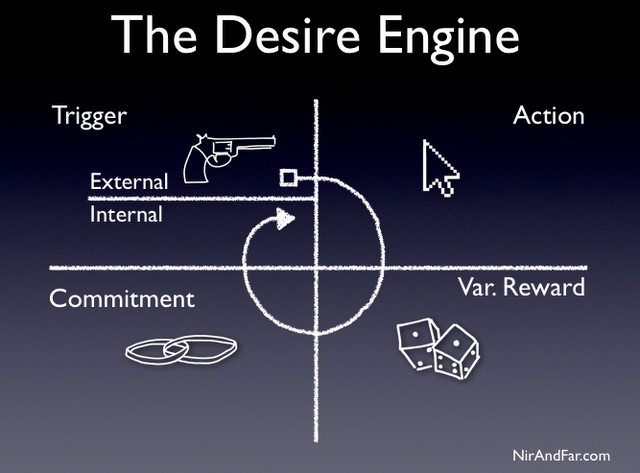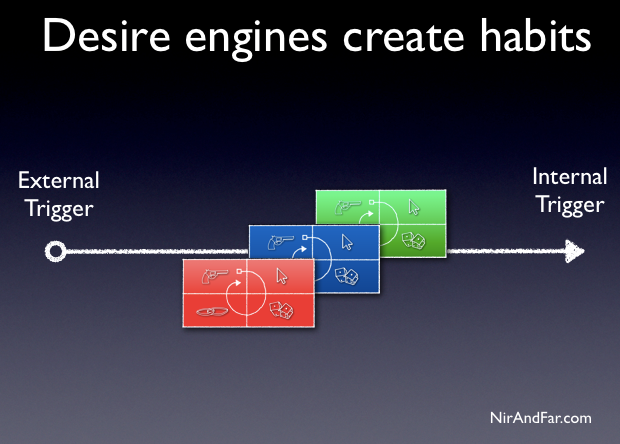I’ve just spent an hour reading the excellent nirandfar blog by Stanford psychology and business lecturer Nir Eyal. The most important post sets out Nir’s concept of the Desire Engine which is a framework for building habit forming services. His other posts explore elements of the framework in more detail (e.g. building commitment by making users do work, and how to hook users with variable rewards) and case studies (e.g. Instagram).
What follows is a summary of the core elements of the theory which I hope will a) firmly cement the framework in my mind, b) convince many of you to go and read Nir’s work in full (if you are responsible for designing or building a consumer internet service then you really should), and c) serve as a quick intro for those of you who are time challenged.
I’d love to get your reactions. As always.

The centrepiece of Nir’s theory is that successful sites push users through the four steps of the Desire Engine every time they visit.
The first step is the trigger that takes them to the site – that could be an email, a post on Twitter or Facebook, or it could be a thought or emotion that occurs to the user and makes them reach for the service (an internal trigger).
Next comes the action the trigger is designed to precipitate – that could be clicking on a link in the email to go to the website (responding to an external trigger) or sharing a photo of something beautiful you’ve just seen on Instagram.
Third up is the reward. This is where the theory gets interesting. Two points stand out for me here – firstly the reward has to be amazing, and secondly the reward shouldn’t be the same every time. Giving the user an amazing reward is hard enough – Facebook gets you pictures of last night’s party, and Twitter gets you breaking news or amazing articles, but most sites fail to really wow – but to keep it interesting for the consumer the reward must be unpredictable. It turns out that our brains are hardwired to find patterns in things and when rewards vary we are compulsively drawn back by a need to find some order. Variability makes us value rewards more and makes sites more addictive. Returning to Facebook and Twitter – the rewards on any given visit vary hugely, and sometimes there are none. Similarly on Instagram – who knows whether people will love your photos or not.
The fourth and final step is commitment. Having enjoyed a reward the users brain is swimming with dopamine and they are happy to do a bit of work and put something back in. Putting something back in should serve two purposes – firstly to make the service better next time they use it, and secondly to get the user to feel more invested in the service and hence committed to it. Dressing avatars, buying virtual goods in games, adding profile information and updating preferences are all good examples of work that users can be asked to do.

By now you may have picked up that there are two types of triggers – internal and external. External triggers are manufactured by the service, and include emails, social media mentions and adverts. Internal triggers originate in the mind of the user when a service becomes associated with thoughts or emotions that occur spontaneously – e.g. read an interesting article, post it on Twitter. Nir’s second major insight is that successful sites drive super growth by transitioning users from relying on external triggers to responding to internal triggers by taking them through the desire engine a few times.
In summary, the key challenges are finding compelling and variable rewards, getting users to commit by doing some work, and designing a user experience that cycles users through the four steps quickly to encourage the development of internal triggers.
(Nic Brisbourne is partner at DFJ Esprit, one of Europe's leading venture capital firms. The post has been reproduced with the author’s permission from his blog, The Equity Kicker)




